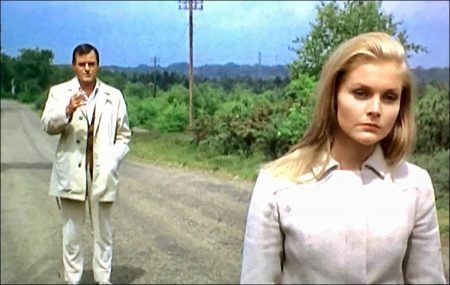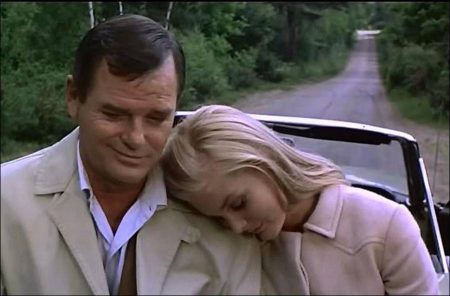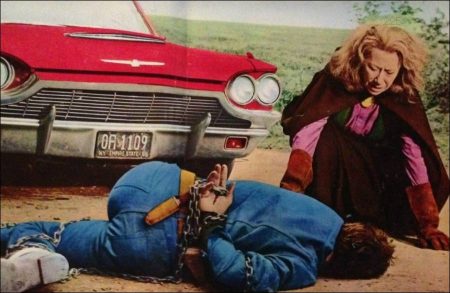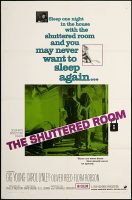Taglines: There are some doors that should never be opened.
The Shuttered Room movie synopsis. In a small island off the American coast, the Whateleys live in an old mill where a mysterious bloody being creates an atmosphere of horror. After her parents get killed by lightning, young Susannah is sent to New York by her aunt Agatha, who wants her to avoid the family curse. Years later, Susannah Whately Kelton (Carol Lynley), now married, persuades her husband to spend a vacation in the abandoned mill. Once on the island, Susannah and Mike Kelton (Gig Young) soon find themselves exposed to the hostility of a gang of thugs led by Ethan (Oliver Reed), Susannah’s brutal cousin.
The Shuttered Room [a.k.a. Blood Island] is a 1967 British horror film directed by David Greene and starring Gig Young and Carol Lynley as a couple who move into a house with dark secrets. It is based on a short story of the same name by August Derleth which Derleth published as a so-called ‘posthumous collaboration with H. P. Lovecraft. The film has also been re-released under the title Blood Island.
Although set in the United States, the film was shot in Kent and Norfolk, England. The film features a large, half-brick, half-timber watermill, which is destroyed by fire in the closing scenes. The building used was Hardingham Mill on the River Yare in Norfolk.
Film Review for The Shuttered Room
August Derleth is a somewhat ambiguous figure in the personal history of HP Lovecraft and his work. On the one hand, Derleth is the reason most people today are at all familiar with Lovecraft. If it weren’t for his Arkham House press keeping Lovecraft’s stories in print, they might otherwise have been lost to pulp horror obscurity. On the other hand, Derleth not only kept Lovecraft’s finished work alive, but contributed posthumous “collaborations” to what he called the Cthulhu Mythos, built on notes or fragments of story ideas Lovecraft left behind… and Derleth wasn’t the writer that Lovecraft was.
He’s not actually a bad writer–he could do some nicely creepy things with the lonely woods and lakes of Wisconsin–but he also had the nerdish need to categorize and rank his monsters. Even in his best stories, someone will pull out a checklist to try and identify the particular Elder God that’s causing all the trouble so it can be dealt with correctly. If nothing else, Derleth’s scope of vision is more narrowly focused than Lovecraft’s and his cosmic horrors aren’t indescribable beings barely comprehensible to the humans who encounter them, but tend to be a tad more localized.
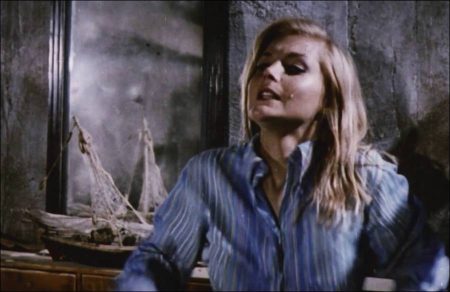
The Shuttered RoomThe Shuttered Room is one of these collaborative works, based on a few sentences in Lovecraft’s notes. I hadn’t read the short story since I was a teenager, nor seen this 1967 film version in nearly as many years. The original story isn’t available online, but as I recall it, a young man, one of the Whateley clan, inherits property in Dunwich, including an old mill that contains the eponymous shuttered room. He is directed to tear down the mill and kill anything living he finds inside. Of course, he doesn’t do this, and the inhabitant of that room manages to slip out and wreak havoc. In spite of the location and Whateley name, the story has more to do with Innsmouth than Dunwich.
The film version gets rid of most of the original story apart from the Whately name (as it’s spelled here) and the central plot idea of a young person inheriting an old mill with a mysterious shuttered room. The Innsmouth connection is lost, but the story still bears some relationship to The Dunwich Horror in a non-supernatural way.
It begins with a little girl saying her prayers before her mother tucks her into bed. After Mom and Dad have gone to their own room and gone to sleep, something unseen opens the door of the room at the top of the stairs and makes its way down.
Red DoorThis door is the most ominous-looking thing in this movie; it’s painted bright red when the rest of the house is in muted browns and greys, and it features a peep-hole ringed with little sharp spikes so that whatever’s normally kept locked in can’t even stick a finger through.
A camera-point-of-view creeps down the stairs to enter the parents’ room and stands briefly beside their bed as they sleep, then goes to the nursery where the little girl wakes and screams. Mom and Dad awake at the commotion. “You forgot to lock the door!” says Dad as the couple heads downstairs to rescue their child from whatever is menacing her. The mother is attacked and falls to the floor, but the father takes hold of the intruder and, dodging the swipes it makes at his face, firmly guides it back upstairs to its room. The red door shuts.
The face of the screaming little girl dissolves to become that of a grown young woman (Carol Lynley, last seen on these pages as Carl Kolchak’s girlfriend). Under the opening credits accompanied by a sultry jazz tune, she sits in a car driving through the countryside with her older, male companion (Gig Young).
When they stop the car and the young woman gets out due to a mild panic attack, we learn that she is Susannah Kelton, nee Whately, and the man is her husband Mike. They haven’t been married long. Susannah was sent away from Dunwich as a small child after her parents were killed and was brought up in New York; she hasn’t seen her old home since then and isn’t happy about returning to it now. The visit is Mike’s idea. Susannah’s just turned 21 and received her inheritance–the old mill seen in the pre-credit prologue. Her husband wants to check out the property. He thinks they could convert the place into a nice summer cottage.
This film was made by Twickenham Studios and, like many UK films of the 1950s and ’60s, stars an American actor or two with an otherwise British cast (See also Dana Andrews, Dean Jagger, Brian Donlevy, and more recently Nick Adams). Here, however, the Norfolk coast of England pretends to be New England. The Keltons have driven up from New York and have to take a tiny one-vehicle ferry to reach Dunwich, which is a derelict fishing village on an island. We could call it Whately Island, since just about everyone on it seems to have this same last name.
Once they cross over, the Keltons run into a group of the local lads out for an afternoon’s entertainment–or, to be accurate, the lads run into them, banging their shabby old pick-up truck against the back bumper of the Keltons’ handsome new Thunderbird when it blocks their way. The boys’ idea of fun is to drag one of their friends behind their pick-up over the dirt road while he stands precariously on a little piece of a board and clings to a rope. Don’t try this at home.
Clawed faceEventually, the youth being dragged along crashes into a barbwire fence just outside the village. Mike Kelton gets out too and, after seeing that the young man isn’t badly hurt, asks the others to point him in the direction of Zebulon Whately, his wife’s uncle.
While Mike introduces himself to Uncle Zebulon–and is warned to take Susannah back to New York before she gets her pretty face clawed up like the last person to spend a night at the old mill, a man who happens to be right there with Uncle Zeb–Susannah is left sitting in the car and gets better acquainted with the rowdy boys. Their leader is Ethan Whately (Oliver Reed). Ethan seems more attracted to the T-Bird than he does to Susannah, but he does take notice of her too. One of the first things he learns about her is that she’s “one of us”–a Whately born on the island.
As soon as the Keltons have driven off, Ethan runs to his Aunt Agatha to shout, “Who is Susannah Whately?” He’s been brought up to believe that the old mill would be coming to him one day and he had no idea there was anyone else in line to inherit this desirable property.
It’s not clearly established that Ethan is Zebulon’s son, or what, but he and Susannah do have a mutual aunt and he expected to inherit her parents’ mill. They must be cousins to a close degree, which only makes Ethan’s attitude toward Susannah even more skeevy as the plot develops.
Meanwhile, the Keltons drive over to the old mill, which has been abandoned since the deaths of Susannah’s parents more than 15 years ago. Trouble at MillSusannah calls it “gruesome” when she first sets eyes on it. The building is falling to pieces, but the setting with the mill pond and trees is quite pretty. Mike hasn’t given up on his country-cottage plans just yet in spite of Uncle Zebulon’s dire warnings. He doesn’t take them seriously, and it doesn’t look like he’s repeated anything Uncle Zeb told him to his wife.
The mill itself is a 3-story brick structure with an attic, and a smaller wooden building containing living quarters is attached to it. The most prominent feature is a sort of clapboard dormer room at the very top that hangs out over the road in front the mill. Although its window is firmly shuttered, the wooden slats are rotting and falling off the sides. There is an opening cut in the floor with long chains dangling down, but most of the rest of the floor has fallen away too.
When I saw The Shuttered Room as a child, those dangling chains were the one thing that frightened me, and the detail I most clearly remembered from this movie. ChainsBut there’s nothing actually ominous about them. It turns out they are there for a purely practical purpose, which Mike Kelton explains: when the mill was functional, carts would drive up under the overhanging room and the chains were used to haul up sacks of grain to be processed down through the mill’s machinery. And yet something is up there; a camera-point-of-view has been keeping an eye on Susannah and Mike through the broken floor of the Shuttered Room since they arrived.
The Keltons go into the living quarters to have a look around. Ethan peeking inBefore they can do much more than express dismay at the cobweb-covered condition of the kitchen and share a kiss, Ethan comes peeking in through the windows and invites them to Aunt Agatha’s. Agatha wants to see her niece.
Ethan leads them along a coastal path past the graveyard where Susannah’s parents are buried, to the tower where Auntie lives. Also at Aunt Agatha’s home is a slatternly, buxom girl named Emma who works for her. Emma is apparently the only woman under 30 on the whole island and she desperately wants to get away from it; the poor girl has nothing better to do than make out with sweaty young Oliver Reed and gaze enviously at Suzannah’s expensive silk stockings that were torn while climbing the cliff path.
So far, we have a very lovely but fragile and naive heroine with a smug and condescending husband old enough to be her father, and some hostile but pathetic local folk. No one I can work up strong sympathies for. But there is one cool character in this story–Aunt Agatha (Flora Robson). She lives in what appears to be an abandoned watchtower with a beautiful pet golden eagle she feeds meaty tidbits by hand. She’s also the one person who knows what’s going on.
Aunt Agatha and eagleLike a Scooby-Doo villain, Aunt Agatha promotes the idea that the abandoned mill is cursed. Her claims aren’t meant for her own wealth or advantage, however, but to try and keep people safely away from what does dwell there. So effective is her plan that the local folk do keep clear of the place. Even the blustering Ethan, who feels the property is rightfully his, says with sincere fearfulness that he’d never dare spend a night in the mill. When it’s his, he intends to knock the building down and use the land for farming.
Aunt Agatha tries to warn off Mike with stories of the curse and how it killed Susannah’s parents–both were “struck by lightning!”–and insists that something just as horrible will befall Susannah if she stays. But Mike simply smirks and doesn’t buy it. He also seems to think that the eagle is responsible for the clawed-up face of Uncle Zebulon’s friend, although he doesn’t deliver this accusation to the old lady directly. And it’s back to the old mill we go. There’s no hotel on the island, so the Keltons intend to knock down the cobwebs and spend the night.
When she enters her nursery, apparently untouched since the day she left it as a four-year-old, Susannah regresses to a childlike state. She hugs her old favorite doll closely as long-suppressed memories begin to return to her. Susannah and the dollhouseOne object of particular interest is a large doll-house. Susannah eyes it warily and tells her husband that, when she was a little girl, she felt that there was someone inside the dollhouse watching her. Or, at least, that there was some presence that felt malevolent toward her in the room.
Mike hears this with his usual condescending smirk and hands her a broom. He suggests she start cleaning the place up while he goes back to the village to buy some groceries for their dinner. Uncle Zebulon is amazed to see that Mike has left his wife alone at the mill, but it’s not the mill that’s a danger to Susannah. After Mike leaves, she takes a few whacks at the cobwebs with the broom, then decides to take a walk instead. Someone does watch her through a peephole in the kitchen wall as she changes out of her torn stockings and skirt-suit and puts on jeans and more sensible boots for a clamber on the beach. It’s the beach where the danger lies, where Ethan and the rest of the boys have gathered and start to stalk her with menacing intent until Mike shows up to beat them up and chase them off with his kung-fu moves.
Actually, this is my primary complaint about this movie. While it’s kind of creepy that somebody is watching Susannah from the moment she returns to the mill, the real threat to her safety never comes from this direction. It’s not whatever’s in the Shuttered Room; it’s Ethan and his gang. This isn’t so much a spooky movie as it is an early example of “hillbilly horror,” like Deliverance or Straw Dogs, where unwary city-folk who intrude on a rural area are set upon by resentful locals. This film is milder than those darker and nastier films from the 1970s. Susannah is threatened with rape attempts a couple of times, but gets away physically unharmed. And Mike never loses his smug detachment so that we can really believe he’s faced with danger; he doesn’t look terribly put out when he rescues his wife, or all that upset later on when the lads take revenge by dragging him down some dirt roads behind his own T-Bird.
Before that T-Bird drag happens, the Thing in the Shuttered Room claims a completely different victim. Poor Emma sneaks out during the night to steal a pair of those silk stockings she so coveted from the luggage the Keltons have left in the back seat of their unlocked car. When she accidentally sets the car’s horn blaring, she runs to hide in the abandoned part of the mill and sprawls on some old gunny sacks to try the stockings on and wave her legs in the air. For this relatively minor transgression, Emma is punished by being clawed to death.
The car’s horn isn’t loud enough to wake Mike immediately, even though he and Susannah are sleeping in the kitchen a few feet away, but it is loud enough that, when Mike does finally come out to shut it off, it masks the sounds of Emma’s screams. He’s never aware that she’s inside the mill, living or dead; it’s Aunt Agatha who finds Emma’s body and takes her clawing attacker back upstairs to be chained up in the Shuttered Room. The sleeping Keltons don’t hear this either.
The next day, Mike calls on Aunt Agatha to learn the truth behind the mill’s “curse”. Before he can get back to the mill, he’s set upon by the boys and taken for a drag. The Dunwich Horror… Not! While his friends are busy with Susannah’s husband, Ethan alone shows up at the mill and tries to rape her. She dissuades him by taking her top and bra off and throwing them at him.
Ethan is momentarily dazed by the sight of his cousin’s breasts, but after she flees he pulls himself together and chases after her again. He winds up opening the red door to the Shuttered Room at the top of the stairs. Thinking that Susannah is hiding from him in there, he sets fire to a headless teddy-bear he finds in the straw and searches the dark corners. He doesn’t notice who else is hiding under the straw until it’s too late. It isn’t Susannah.
This is where the similarity to The Dunwich Horror kicks in, only Susannah certainly isn’t a female Wilbur Whateley, and the “Horror” is entirely human. It’s hard to say what exactly is wrong with Susannah’s sister. When we and Susannah finally get a good look at her, she doesn’t appear to be deformed–and who wouldn’t be emotionally and developmentally stunted after being locked up in the attic her whole life? There’s nothing about her that appears frog-like, as the creature in Derleth’s story does. Her claws are untrimmed fingernails, and not notably long nails either. I’m not even sure the two are supposed to be twins, since the “Horror” isn’t played by Carol Lynley. She looks rather more like Patty Duke in The Miracle Worker, if Annie Sullivan had never shown up to help her.
The only supernatural element in the story is a moment of psychic sympathy between the two sisters when Susannah’s husband, having escaped from the gang of youths, arrives to escort her out of the mill for the last time. That headless teddy-bear was still burning when Ethan dropped it when the Horror attacked him. The Shuttered Room is on fire. Even though she’s safely outdoors and doesn’t see the smoke and flames, Susannah senses her sister’s distress and sends Mike back into the mill to try and get her out. Red Door, burningAunt Agatha shows up to go upstairs with him… but she has other ideas about the best way to deal with the problem of her dangerous niece.
It isn’t a bad movie for what it is. Most of the principal actors are good (Robson, Reed, and Lynley; I obviously didn’t take to Gig Young’s Mike); the jazz score is effective; and the sun-dazzled Norfolk-as-Massachusetts scenery is nice. But what this is ain’t Lovecraft.
The Shuttered Room (1967)
Directed by: David Greene
Starring: Oliver Reed, Gig Young, Carol Lynley, Flora Robson, Judith Arthy, Rick Jones, Ann Bell, William Devlin, Celia Hewitt, Murray Evans, Robert Cawdron, Peter Porteous
Screenplay by: D. B. Ledrov, Nathaniel Tanchuck
Production Design by: David C. Anderson
Cinematography by: Kenneth Hodges
Film Editing by: Brian Smedley-Aston
Costume Design by: Caroline Mott
Art Direction by: Brian Eatwell
Music by: Basil Kirchin
MPAA Rating: None.
Distributed by: Warner Bros. Pictures, Seven Arts
Release Date: June 27, 1967
Views: 354
